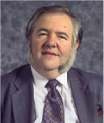Ionic Liquids—Progress on the Fundamental Issues
Douglas R. MacFarlane A C and Kenneth R. Seddon B CA School of Chemistry, Monash University, Clayton VIC 3800, Australia.
B QUILL Research Centre, The Queen’s University of Belfast, Belfast BT9 5AG, UK.
C Corresponding authors: Email: doug.macfarlane@sci.monash.edu.au; k.seddon@qub.ac.uk

Doug MacFarlane (B.Sc. Victoria University of Wellington, New Zealand; Ph.D. Purdue University, USA) heads the School of Chemistry at Monash University, Melbourne. His reseach interests include the materials science of amorphous matter, including ionic liquids, and applications in electrochemical devices, and have led to over 200 papers and 10 patents. He is also an Editorial Committee member of the Australian Journal of Chemistry. |

Ken Seddon (B.Sc.(Hons) Liverpool University; Ph.D. Liverpool University; MA Oxford University; FRSC; CChem) is the Chair of Inorganic Chemistry at the Queen’s University of Belfast, Director of QUILL, Guest Professor at the Dalian Institute of Chemical Physics, Professor Catedrático Visitante of the New University of Lisbon at the ITQB, and Adjunct Professor and Adjunct Director of the Centre of Green Manufacturing at the University of Alabama. His research interests include ionic liquids, crystal engineering, chemical weapons, and conservation of ancient manuscripts, leading to ten books, and over 290 papers and 20 patents. He was recently presented with the 2006 Queen’s Anniversary Prize for Higher and Further Education at Buckingham Palace. |
Australian Journal of Chemistry 60(1) 3-5 https://doi.org/10.1071/CH06478
Submitted: 18 December 2006 Accepted: 18 December 2006 Published: 29 January 2007
Abstract
Ionic liquids challenge conventional descriptions of fluids in a variety of ways. In the past, it has been common to oversimplify their behaviour and to ignore the complexity that was possible, given the burgeoning range of ionic liquids available. Here we discuss what is meant by the term ‘ionic liquid’ and some of the key fundamental issues in understanding their properties.
[1]
[2]
M. Deetlefs,
K. R. Seddon,
Chim. Oggi Chem. Today 2006, 24, 16.
| Crossref | GoogleScholarGoogle Scholar |
| Crossref | GoogleScholarGoogle Scholar |
| Crossref | GoogleScholarGoogle Scholar |
| Crossref | GoogleScholarGoogle Scholar |
| Crossref | GoogleScholarGoogle Scholar |
2007.
[9]
P. C. Howlett,
E. I. Izgorodina,
M. Forsyth,
D. R. MacFarlane,
Z. Phys. Chem. 2006, 220, 1483.
| Crossref | GoogleScholarGoogle Scholar |
| Crossref | GoogleScholarGoogle Scholar |
| Crossref | GoogleScholarGoogle Scholar |
| Crossref | GoogleScholarGoogle Scholar |
| Crossref | GoogleScholarGoogle Scholar |
| Crossref | GoogleScholarGoogle Scholar |
| Crossref | GoogleScholarGoogle Scholar |
| Crossref | GoogleScholarGoogle Scholar |



